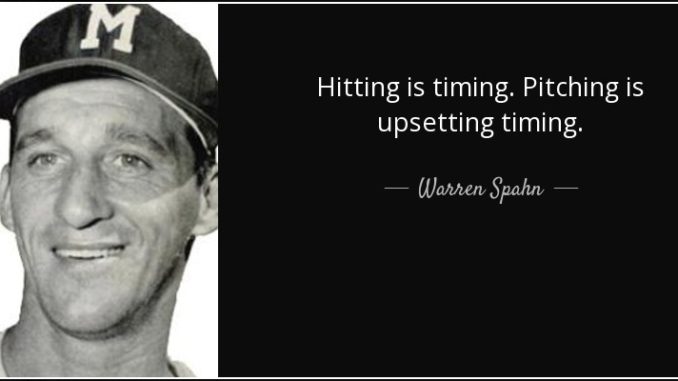
When a player is struggling to consistently hit the ball hard, they will say that their “timing” is off. They are early or late to make contact and they can’t seem to hit the ball they way they want to. I often get asked “what is the best way to improve timing?” The players or coaches are looking for a magic drill or mechanical cue that will help timing, but as is most things about hitting, it isn’t that simple.
Timing is defined as the choice, judgment, or control of when something should be done. So in the case of hitting, timing is deciding when you should start the swing. A hitter that has good timing can consistently decide when to start the swing to make solid contact. A hitter with bad timing has trouble with this decision. But why are some hitters good at this decision? It typically can be explained by analyzing their mechanics and swing quickness.
A fastball released from the pitchers hand at 90 mph, can reach the plate in .4 seconds. It takes about .175 seconds to pick up the ball and process the information, such as the spin, location and velocity. That leaves just .225 seconds to decide if, where, and when to swing and to complete the swing. A good hitter typically takes about .15 seconds to swing the bat and .025 seconds to signal the muscles to swing once one has decided to swing. That leaves the hitter with just .05 seconds to decide if, where and when to swing. .05 seconds is such a short amount of time, no wonder hitting is so hard! That’s 1/20th of a second! And, even if you decide on the right time to swing, you can still miss high with the bat and hit the top of the ball for a ground out, or miss low and hit the bottom of the ball for a fly out. The brain must make so many calculations about where the ball will be in such a short amount of time.
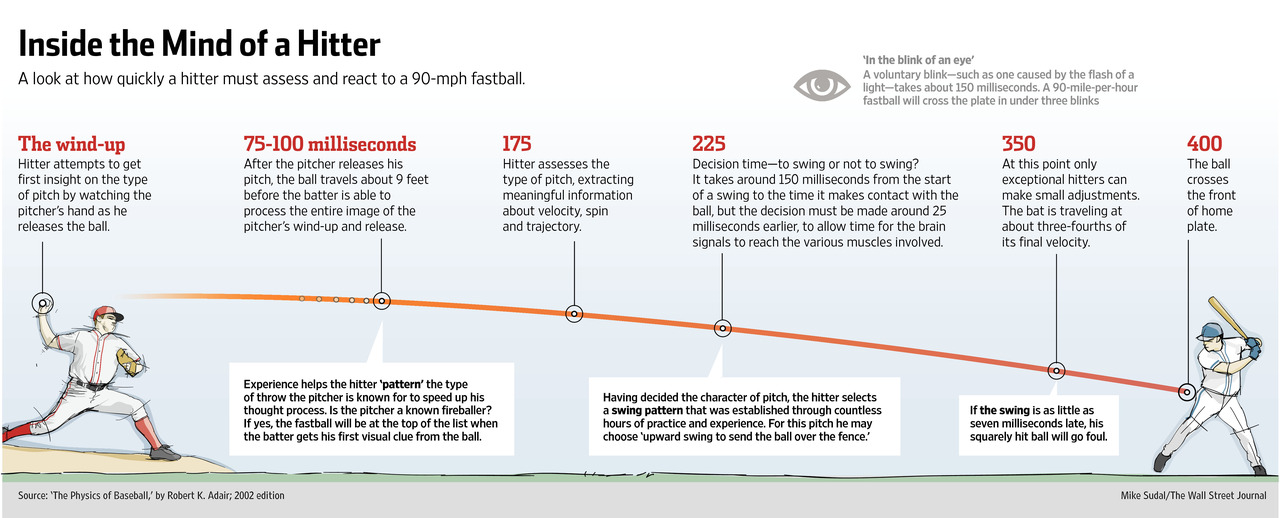
The best way to improve timing is to get quicker. As I said before, good professional hitters are in the .15 second range to swing the bat to contact with the ball. But an amateur hitter could be much slower. They could be .20 or more to contact. No wonder they can’t hit 90 mph pitching. All of their .05 reaction time was eaten up by the extra swing time. That’s why against really fast pitching, hitters appear to be swinging when the ball in already in the catchers mitt. It is impossible for them to hit fast pitching with their swing quickness.
If you can get a quicker swing, you will be able to see the ball longer and wait longer before you decide to swing. This allows you to process the ball longer so you are going to be more accurate with your prediction of where the ball is going to be by the time it reaches the plate. You will be able to better recognize weather it is a curveball, fastball or slider. That will tell you where to swing. you will be able to see more of the pitches flight which will allow you to gauge the speed better and you can better decide when to swing.
To further prove that swing quickness will help timing, lets look at it from a pitchers perspective. As Warren Spahn said “Hitting is timing. Pitching is upsetting timing.” How do pitchers attempt to upset hitters timing? Most commonly they do two things. Try to throw harder, and try to throw the ball with movement. Everyone agrees that a 100 mph pitch is harder to hit than a 90 mph pitch, all other things being equal. While it is hard to hit a 90 mph pitch, a 100 mph pitch is near impossible.
Throwing a ball with movement is also commonly done to upset timing. This is effective because the hitter now has to try and judge where the ball is going to break to. They also have to wait longer to swing because typically breaking pitches are slower than what the hitter is expecting with a fastball. This can throw off their timing.
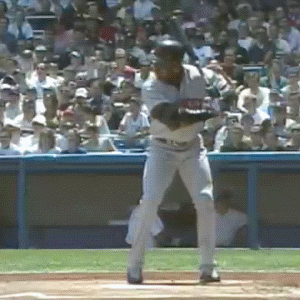
Having a quicker swing can help counteract the things pitchers are doing to upset timing. A quicker swing has a similar affect as facing a slower pitch. This is because you get more time to see the ball with a quicker swing. It also allows you to see a breaking pitch for longer to better judge its location.
Developing a quicker swing is the first thing I recommend to help timing. Even if you are not having timing issues now, improving swing quickness will always be helpful especially as you move up to higher levels of play, with better pitchers. But there is another issue I commonly see with players who struggle with timing. They don’t practice enough at hitting speeds they will see in games.
When I ask hitters struggling with timing what they are doing in practice, I hear two common answers.
1- hitting off of the tee
2- hitting front/side soft toss
These practice methods are not sufficient to improve hitting game-speed pitching.
Hitting off a batting tee is a common form of practice. I think it is a very useful tool to hit balls when you are first learning a new movement. Sometimes hitting a moving ball is too overwhelming when you are trying to learn a new movement. Practicing off a tee until you are more familiar with the movement and can do it while hitting a moving ball, is a smart way of training. However only practicing off a tee is not preparing you for live hitting. A ball off of a tee doesn’t require any timing. The ball is stationary. So how do you expect hitting off a tee to help your timing?
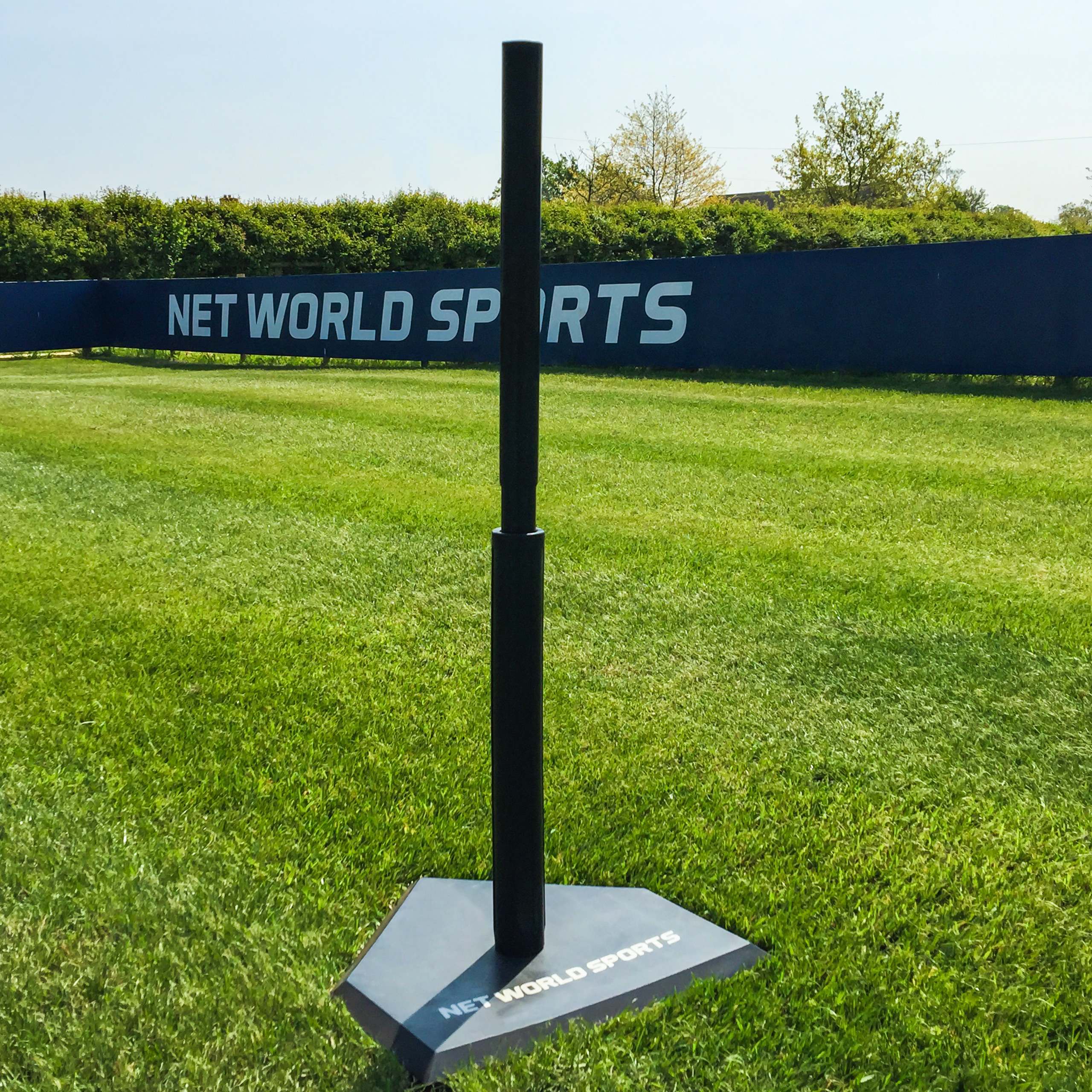
Soft Toss/side toss is also not enough. It is an improvement over the tee because at least the ball is moving. However, the ball is only moving at very slow speeds. A 30 mph underhand toss is very different than a game speed fastball.
The way that hitters decide where and when to swing is based on their experience. The hitter will try to pick up as much information as possible based on the speed of the ball, the spin, the release point etc.. and they have to calculate based on their experience where the ball will end up and where to swing. Good experienced hitters have hundreds of thousands of reps of pitches they have seen and use that information to hit better. However, younger players do not have this internal database to tap into. They are going to be fooled more and be off on their timing just from inexperience. Soft toss pitches do not provide the same experience as game pitches. The speed and the angle the ball is coming in on is completely different.
So what is the best way to practice timing? You must hit game speed pitching. For younger players, having a coach throw overhand from the mound at similar speeds to the game is a very effective. This also applies for older players, however typically it is hard to find pitchers who can throw at game speed. Even if the practice pitcher can’t throw game-speed, throwing batting practice as hard as possible is a good option.
The best option for most players is to hit off of a pitching machine. They make great pitching machines nowadays that are very accurate and can throw a wide variety of breaking pitches. These machines are going to throw the closest to game-like conditions, but really any standard pitching machine will work. If the machine can throw 75+ mph that is going to provide the hitter with faster speeds that most batting practice pitchers don’t throw.
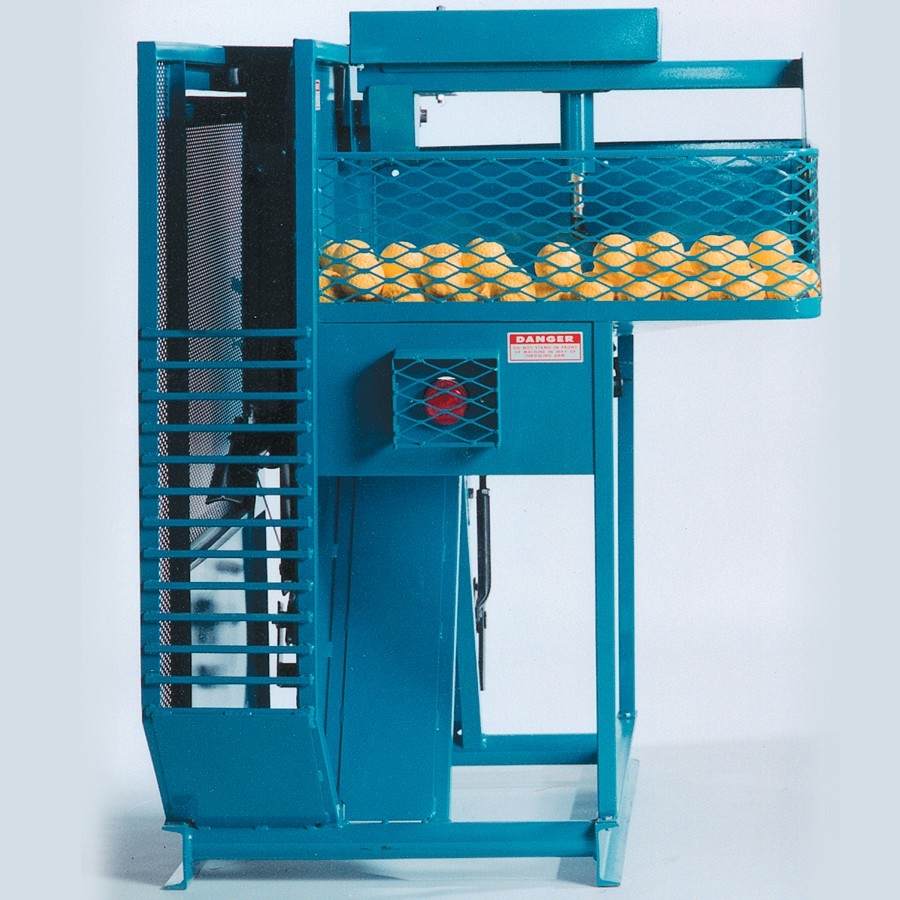
The only problem with some machines is that you are missing the windup of the pitcher. Many hitters use the pitcher’s windup to start their “load” and or “stride.” If a hitter struggles with this when hitting off a machine, I would recommend that they widen their stance and try to hit without a stride. Just pick up the front heel and drop in back down to initiate their swing. Also, if they try to “preload” the body by having less pre-swing movement, this will help when practicing off of a machine.
Summary
There are many factors that effect timing. Having a quick swing is the best way to improve timing and should be worked on first. After working on swing quickness it is also important to practice in game-like scenarios rather than non-challenging batting practice.
For more information on how to work on improving swing quickness please don’t hesitate to contact me, so we can talk about working in person.
